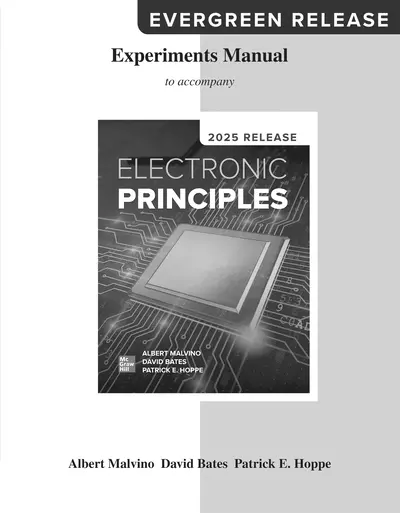My Account Details

ISBN10: 1265465797 | ISBN13: 9781265465797

* The estimated amount of time this product will be on the market is based on a number of factors, including faculty input to instructional design and the prior revision cycle and updates to academic research-which typically results in a revision cycle ranging from every two to four years for this product. Pricing subject to change at any time.
Instructor Information
Quick Actions (Only for Validated Instructor Accounts):
Electronic Principles continues its tradition as a clearly explained, in-depth introduction to the electronic principles of semiconductor devices, circuits, and systems. Written in an easy-to-read conversational style, semiconductor devices and circuits are explored, including practical applications where they are found. Electronic Principles' subject matter includes updated semiconductor devices and systems including emerging wide bandgap power FETs and an introduction to Industry 4.0. Circuit operation and troubleshooting techniques are "brought to life" with Multisim circuit simulation files found within Connect.
Experiment 1. Voltage and Current Sources
Experiment 2. Thevenin’s and Norton’s Theorems
Experiment 3. Troubleshooting
Experiment 4. Semiconductor Diodes
Experiment 5. The Diode Curve
Experiment 6. Diode Approximations
System Application 1. Input Protection
Experiment 7. Rectifier Circuits
Troubleshooting 1. Diode Circuits
Experiment 8. The Capacitor-Input Filter
Experiment 9. Limiters and Peak Detectors
Experiment 10. DC Clampers and Peak-to-Peak Detectors
Experiment 11. Voltage Doublers
Experiment 12. The Zener Diode
Experiment 13. The Zener Regulator
System Application 2. Voltage Regulation
Troubleshooting 2. Power Supply Circuits
Experiment 14. Optoelectronic Devices
Experiment 15. The CE Connection
Experiment 16. Transistor Operating Regions
Experiment 17. Base Bias
Experiment 18. LED Driver and Phototransistor Circuits
Experiment 19. Setting Up a Stable Q Point
Experiment 20. Biasing PNP Transistors
Experiment 21. Transistor Bias
Experiment 22. Coupling and Bypass Capacitors
Experiment 23. The CE Amplifier
Experiment 24. Other CE Amplifiers
Experiment 25. Cascaded CE Stages
Experiment 26. CC and CB Amplifiers
Experiment 27. Emitter Follower Applications
Troubleshooting 3. Single Stage and Multistage Transistor Circuits
Experiment 28. Class-A Amplifiers
Experiment 29. Class-B Push-Pull Amplifiers
Experiment 30. An Audio Amplifier
Experiment 31. Class-C Amplifiers
System Application 3. Multistage Transistor Application
Experiment 32. JFET Bias
Experiment 33. JFET Amplifiers
Experiment 34. JFET Applications
Experiment 35. Power FETS
Experiment 36. The Silicon Controlled Rectifier
Experiment 37. Frequency Effects
System Application 4. Frequency Response of Coupling and Bypass Capacitors
Experiment 38. The Differential Amplifier
Experiment 39. Differential-Amplifier Supplement
Experiment 40. Introduction to OP-AMP Circuits
Experiment 41. Inverting and Noninverting Amplifiers
Experiment 42. The Operational Amplifier
Experiment 43. Small- and Large-Signal Output Impedances
Experiment 44. Summing Amplifiers
Experiment 45. VCVS Feedback
Experiment 46. Negative Feedback
Experiment 47. Gain-Bandwidth Product
Experiment 48. Linear IC Amplifiers
System Application 5. Single Power Supply Audio Op-Amp Application
Experiment 49. Current Boosters and Controlled Current Sources
Experiment 50. Active Low-Pass Filters
Experiment 51. Active Butterworth Filters
Experiment 52. Active Diode Circuits and Comparators
Experiment 53. Waveshaping Circuits
Experiment 54. The Wien-Bridge Oscillator
Experiment 55. The LC Oscillator
Experiment 56. Op-Amp Applications: Signal Generators
System Application 6. Power Supply Monitoring Circuit
Experiment 57. The 555 Timer
Experiment 58. 555 Timer Applications
Experiment 59. Shunt Regulators
Troubleshooting 4. Shunt Regulator Circuits
Experiment 60. Series Regulators
Experiment 61. Three-Terminal IC Regulators
Appendix
Main parts and equipment
Need support? We're here to help - Get real-world support and resources every step of the way.